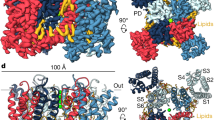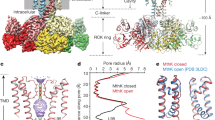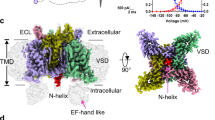Abstract
Fast N–type inactivation of voltage–dependent potassium (Kv) channels controls membrane excitability and signal propagation in central neurons and occurs by a 'ball–and–chain'–type mechanism. In this mechanism an N–terminal protein domain (inactivation gate) occludes the pore from the cytoplasmic side. In Kv3.4 channels, inactivation is not fixed but is dynamically regulated by protein phosphorylation. Phosphorylation of several identified serine residues on the inactivation gate leads to reduction or removal of fast inactivation. Here, we investigate the structure–function basis of this phospho–regulation with nuclear magnetic resonance (NMR) spectroscopy and patch–clamp recordings using synthetic inactivation domains (ID). The dephosphorylated ID exhibited compact structure and displayed high–affinity binding to its receptor. Phosphorylation of serine residues in the N– or C–terminal half of the ID resulted in a loss of overall structural stability. However, depending on the residue(s) phosphorylated, distinct structural elements remained stable. These structural changes correlate with the distinct changes in binding and unbinding kinetics underlying the reduced inactivation potency of phosphorylated IDs.
This is a preview of subscription content, access via your institution
Access options
Subscribe to this journal
Receive 12 print issues and online access
$189.00 per year
only $15.75 per issue
Buy this article
- Purchase on Springer Link
- Instant access to full article PDF
Prices may be subject to local taxes which are calculated during checkout




Similar content being viewed by others
References
Greengard, P., Jen, J., Nairn, A.C. & Stevens, C.F. Science 253, 1135–1138 (1991).
Huganir, R.L., Delcour, A.H., Greengard, P. & Hess, G.P. Nature 321, 774–776 (1986).
Numann, R., Catteral, W.A. & Scheuer, T. Science 254, 115–118 (1991).
Drain, P., Dubin, A.E. & Aldrich, R.W. Neuron 12, 1097–1109 (1994).
Covarrubias, M., Wei, A., Salkoff, L. & Vyas, T.B. Neuron 13, 1403–1412 (1994).
Beck, E.J., Sorensen, R.G., Slater, S.J. & Covarrubias, M. J. Gen. Physiol. 112, 71–84 (1998).
Armstrong, C. & Bezanilla, F.J. J. Gen. Physiol. 70, 567–590 (1977).
Hoshi, T., Zagotta, W.N. & Aldrich, R.W. Science 250, 533–538 (1990).
Zagotta, W.N., Hoshi, T. & Aldrich, R.W. Science 250, 568–571 (1990).
Murrell–Lagnado, R.D. & Aldrich, R.W. J. Gen. Physiol. 102, 949–975 (1993).
Rettig, J. et al. EMBO J. 11, 2473–2486 (1992).
Demo, S.D. & Yellen, G. Neuron 7, 743–753 (1991).
Antz, C. et al. Nature 385, 272–275 (1997).
Ruppersberg, J.P., Frank, R., Pongs, O. & Stocker, M. Nature 353, 657–660 (1991).
Stephens, G.J. & Robertson, B. J. Physiol. 484, 1–13 (1995).
Oliver, D., Hahn, H., Antz, C., Ruppersberg, J.P. & Fakler, B. Biophys. J. 74, 2318–2326 (1998).
Johnson, L.N. & O'Reilly, M. Curr. Opin. Struct. Biol. 6, 762–769 (1996).
Bundi, A. & Wüthrich, K. Biopolymers 18, 185–297 (1979).
Lin, K., Rath, V.L., Dai, S.C., Fletterick, R.J. & Hwang, P.K. Science 273, 1539–1541 (1996).
Russo, A., Jeffrey, P.D. & Pavletich, N.P. Nature Struct. Biol. 3, 696–700 (1996).
Hoffman, D.A., Magee, J.C., Colbert, C.M. & Johnston, D. Nature 387, 869–875 (1997).
Hille, B. Ionic channels of excitable membranes (Sinauer Associates Inc., Sunderland, Massachusetts; 1992).
Debanne, D., Guerineau, N.C., Gähwiler, B.H. & Thompson, S.M. Nature 389, 286–289 (1997).
Fakler, B. et al. Cell 80, 149–154 (1995).
Frank, R. & Gausepohl, H. Modern methods in protein chemistry (de Gruyter, Berlin, Federal Republic of Germany, 1988).
Freund, J. & Kalbitzer, H.R. J. Biomol. NMR 5, 321–322 (1995).
Jeener, J. J. Chem. Phys. 71, 4546–4553 (1979).
Aue, W.P., Bartholdi, E. & Ernst, R. J. Chem. Phys. 64, 2229–2246 (1976).
Davis, D.G. & Bax, A. J. Am. Chem. Soc. 107, 2820–2821 (1985).
Brünger, A.T. X–PLOR (version 3.851) manual (Yale University Press, New Haven, Connecticut, 1992).
Kirkpatrick, S., Gelatt, G.C. & Vecchi, M.P. Science 220, 671–680 (1983).
Neidig. K.P. et al. J. Biomol. NMR 6, 255–270 (1995).
Acknowledgements
The authors would like to thank K.C. Holmes for continuous support, M. Geyer for technical help and J.P. Adelman, J. Maylie, J. Mosbacher and G. Yellen for helpful comments and reading of the manuscript. The work was supported by the Deutsche Forschungsgemeinschaft (Fa 332/2–1).
Author information
Authors and Affiliations
Corresponding author
Rights and permissions
About this article
Cite this article
Antz, C., Bauer, T., Kalbacher, H. et al. Control of K+ channel gating by protein phosphorylation: structural switches of the inactivation gate. Nat Struct Mol Biol 6, 146–150 (1999). https://doi.org/10.1038/5833
Received:
Accepted:
Issue Date:
DOI: https://doi.org/10.1038/5833
This article is cited by
-
Modulation of K+ channel N-type inactivation by sulfhydration through hydrogen sulfide and polysulfides
Pflügers Archiv - European Journal of Physiology (2019)
-
Ca2+/calmodulin regulates Kvβ1.1-mediated inactivation of voltage-gated K+ channels
Scientific Reports (2015)
-
Cell signaling, post-translational protein modifications and NMR spectroscopy
Journal of Biomolecular NMR (2012)
-
Acoustic environment determines phosphorylation state of the Kv3.1 potassium channel in auditory neurons
Nature Neuroscience (2005)



